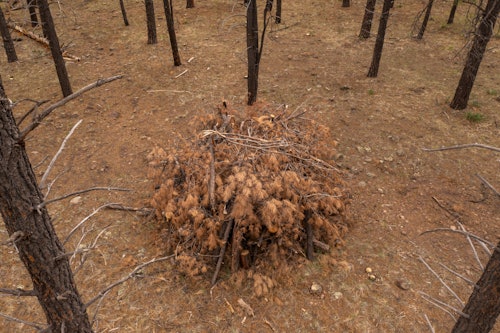The U. S. government is investing over US$7 billion in the coming years to try to manage the nation’s escalating wildfire crisis.
The U. S. government is in the coming years to try to manage the nation’s .
That includes a commitment to in the next ten years by expanding forest-thinning efforts and controlled burns. While that sounds like a lot — 60 million acres is about the size of Wyoming — it’s nowhere close to enough to treat every acre that needs it. So, where can taxpayers get the biggest bang for the buck? I’m a in Montana.
In a , my colleagues and I mapped out where forest treatments can do the most to simultaneously protect communities — by preventing wildfires from — and also protect the forests and the climate we rely on by keeping carbon out of the atmosphere and . Wildfires are becoming more severe Forests and fires have always been . Fires in dry conifer forests like ponderosa pine historically occurred frequently, clearing out brush and small trees in the understory.
As a result, fires had less fuel and tended to stay on the ground, doing less damage to the larger, older trees. That changed after European colonization of North America ushered in a legacy of fire suppression that . In the absence of fire, dry conifer forests that now allows wildfires to climb into the canopy.
A firefighter sets a controlled burn to remove undergrowth that could fuel a fire. The wildfire burn area is increasing in the US Since 1983, when federal agencies began using the current method of tracking wildfires, the annual number of acres burned in the U. S.
has trended upward, with more high-severity fires. 2004 fires and acres do not include state lands for North Carolina. In addition to excess fuels, all forest types are and due to climate change.
The expanding living in and near forests and their roads and power lines increases the risk of . Collectively, it’s not surprising that . In response, the U.
S. is facing increasing pressure to protect communities from high-severity wildfires while also reducing the country’s impact on climate change – including from carbon released by wildfires. High-risk areas that meet both goals To find the locations with the greatest potential payoff for forest treatments, we started by identifying areas where forest carbon is more likely to be lost to wildfires compared to other locations.
In each area, we considered the likelihood of wildfire and calculated how much forest carbon might be lost through and . Additionally, we evaluated whether the conditions in for trees to regenerate over time. When forests regrow, they absorb carbon dioxide from the atmosphere and lock it away in their wood, eventually making up for the carbon lost in the fire.
In particular, we found that forests in California, New Mexico, and Arizona were more likely to lose a large portion of their carbon in a wildfire and also have a tough time regenerating because of stressful conditions. Areas with high potential for protecting both human communities and carbon storage. When we compared those areas to detailing high wildfire risk to communities, we found several hot spots for simultaneously reducing wildfire risk to communities and stabilizing stored carbon.
Forests surrounding Flagstaff, Arizona; Placerville, California; Colorado Springs, Colorado; Hamilton, Montana; Taos, New Mexico; Medford, Oregon; Wenatchee, Washington, are among locations with good opportunities for likely achieving both goals. Why treating forests is good for carbon, too Forest thinning is like weeding a garden: It in dry conifer forests to leave behind space for the larger, older trees to continue growing. Repeatedly applying controlled burns maintains that openness and reduces fuels in the understory.
Consequently, when a wildfire occurs in a thinned and burned area, flames are and out of the canopy. Although forest thinning and controlled burning remove carbon in the short term, are more a subsequent wildfire. In the long term, that’s a good outcome for carbon and climate.
Living trees continue to absorb and store carbon from the atmosphere, as well as provide critical seeds and shade , grow, and recover the carbon lost to fires. Of course, forest thinning and controlled burning are not a silver bullet. Using the National Fire Protection Agency’s and will help people make their properties less vulnerable to wildfires.
Allowing can reduce future wildfire severity. And the world needs to rapidly transition away from fossil fuels to curb that increase the risk of wildfires becoming community disasters. .
From: inverse
URL: https://www.inverse.com/science/united-states-wildfire-hot-spots



